Guest post by Heidi A. Strobel, University of North Texas
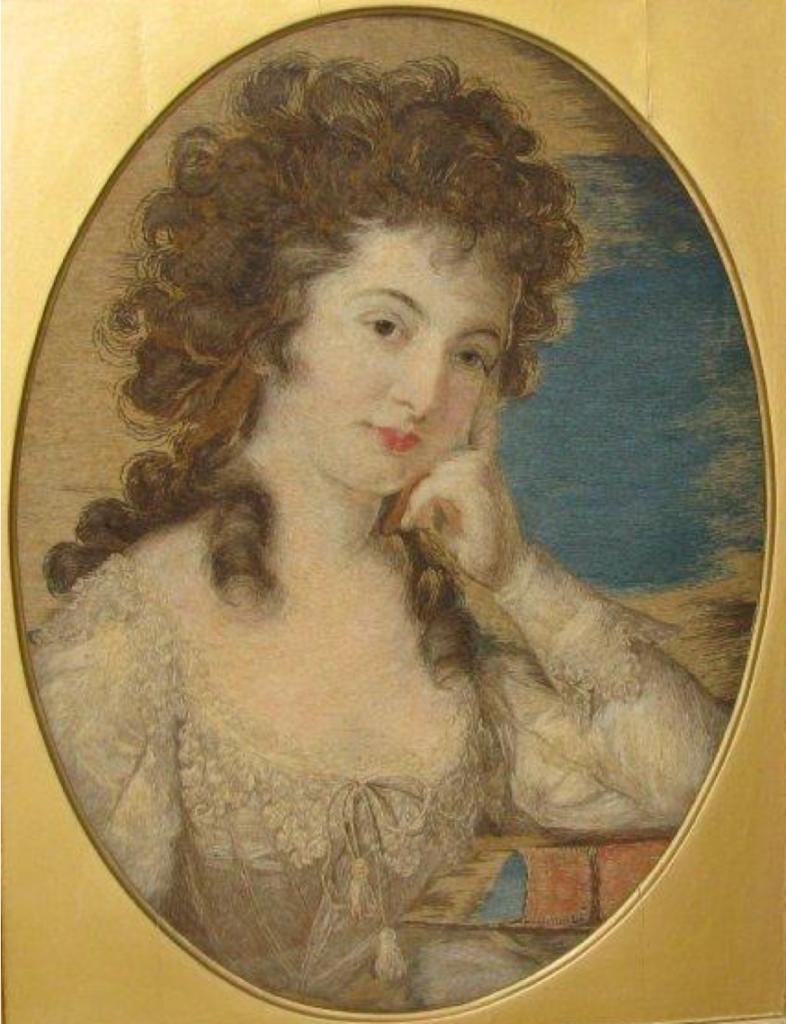
Gallery Pioneer
In 1809, embroiderer Mary Linwood (1755–1845) opened a gallery in Leicester Square, London, the first one run by a woman in the capital. It featured her full-scale textile copies of paintings by popular British artists such as Sir Joshua Reynolds, Thomas Gainsborough, and George Morland, among others. The gallery, which remained open for thirty-six years, was a must-see destination in London, visited by multiple generations of the British royal family, actress Sarah Siddons, and gossipy diarist Joseph Farington. When Linwood died in March of 1845, her estate was worth £45,000, or roughly £5,199,822 ($5,460,000) today, an extraordinary sum for a woman born into a modest family. [1]
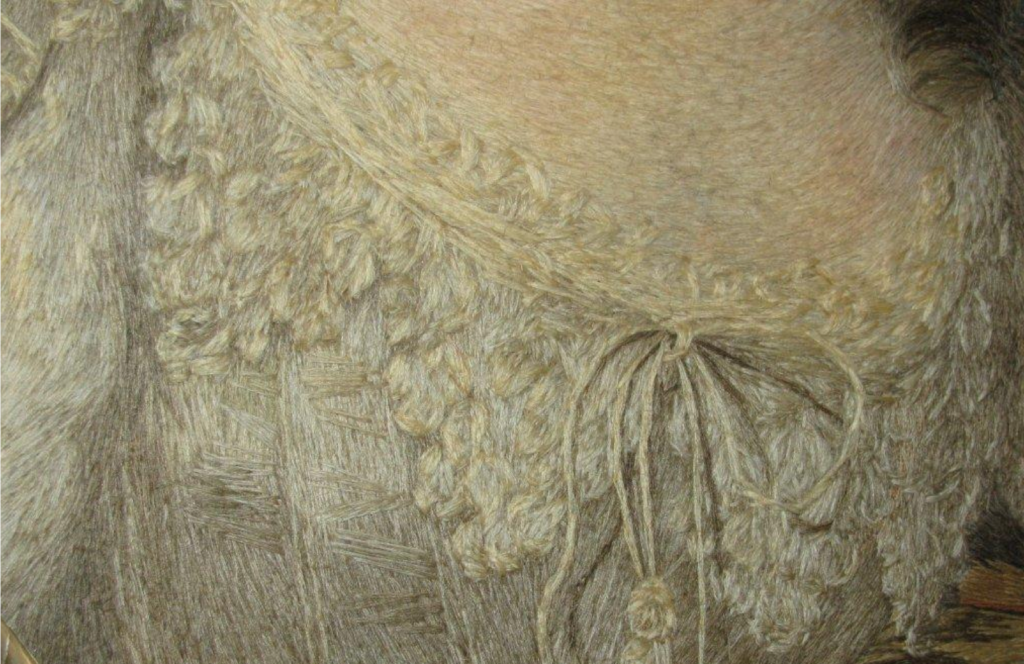
In 1785, Linwood commissioned a pastel portrait by popular artist John Russell. Soon after it was completed, Linwood created an embroidered replica of it which embodies some of the contradictions that characterized her artistic career: copy and original, portrait and self-portrait, and professional and amateur. She added innovative features to it, such as the bows on her dress that dangle outside the oval enclosure of the frame, wittily playing with the two dimensionality of the artwork. In the portrait, Linwood’s arm rests on Leonardo’s Treatise on Painting, a subtle nod to her participation in the London art world and an acknowledgement of the amount of time it took for her to design, create, and display her works.
Early Life and Training
We do not know much about Linwood’s early life, a typical gap in women’s histories. The eldest of six children, she was born in Birmingham to Matthew and Hannah Linwood. Mary likely inherited her love of textiles from both her father, who was trained as a linen draper, and her mother, who founded and directed a boarding school in Leicester, where the family moved in 1763. Hannah Linwood was a talented embroiderer and passed this skill on to her daughter Mary, who also attended the school known as the Priory. Hannah soon became the family’s breadwinner, providing her daughter Mary with a role model for her later entrepreneurship. In the early 1770s, Mary joined the Priory’s staff, teaching girls from prosperous Leicester, Birmingham, and London families. Linwood never married, which certainly allowed her more autonomy than her married counterparts.
Linwood the Entrepreneur
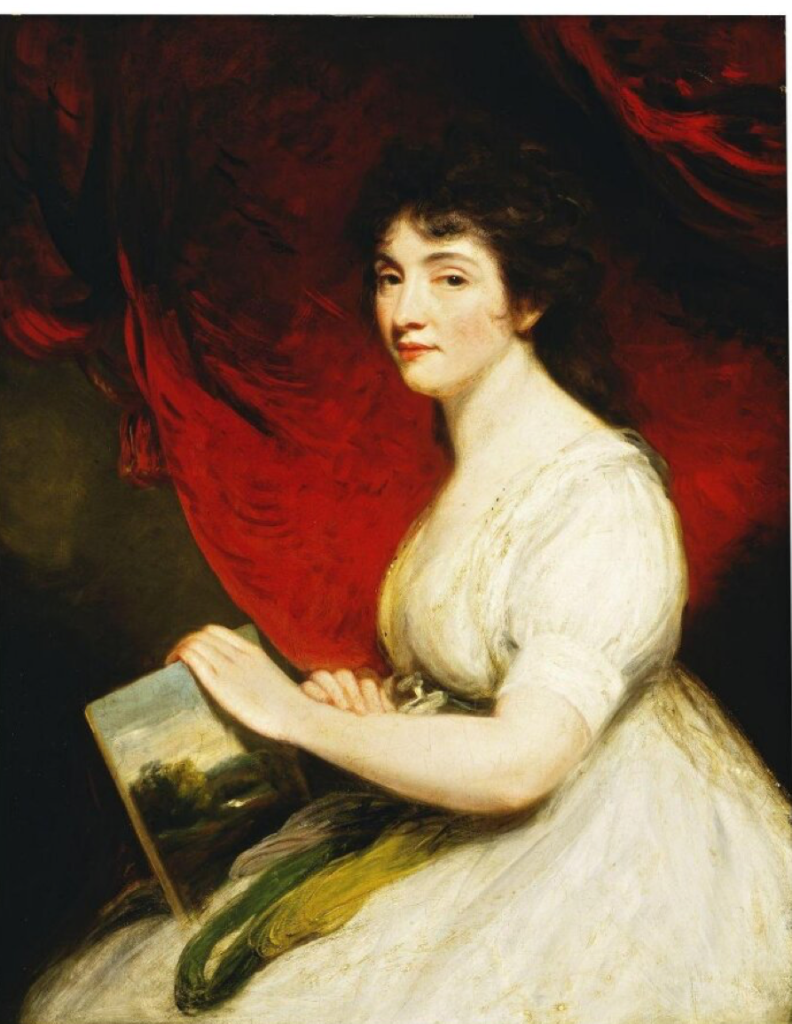
Long before multi-tasking became a feature of modern life, Linwood divided her time between London and Leicester, working at the Priory boarding school and at her London gallery in Leicester Square. Linwood’s two occupations—educator and artist—were, however, closely related. The polite art of embroidery was taught at the boarding school that she led, but the professional practices that made the school a success contributed to the flourishing of her gallery. Linwood invested wisely, using her gallery proceeds to build an art collection on which she based her full-scale, high-quality embroidered copies.
During her lifetime, Linwood refused to sell her work, a factor that certainly contributed to her posthumous reputation as an accomplished amateur copyist, rather than an innovative entrepreneur. Ever the educator, Linwood wanted the collection to stay intact so that she could educate her visitors about an emergent school of British painting whose stars included Reynolds, Gainsborough, Morland, and George Stubbs. Linwood believed that their work was equal in quality to paintings produced by Continental artists such as Jacques-Louis David and Francisco Goya. In her Leicester Square Gallery, she exhibited 65 textiles, 85% of which were copies of British paintings, many of which were landscape scenes. In John Hoppner’s 1800 portrait of Linwood, the canvas in her lap emphasizes her preference for the particularly British genre of landscape painting that was easily understood by viewers with no specialized artistic knowledge.
Linwood’s Professional Career
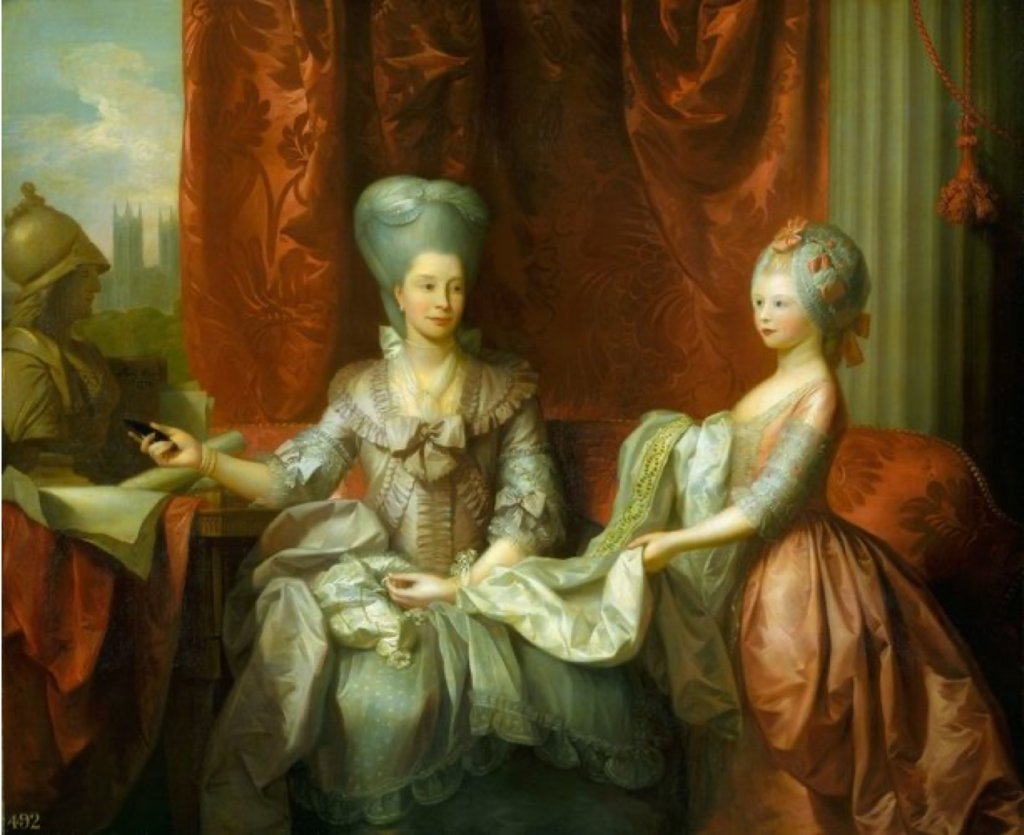
With Queen Charlotte’s support, Linwood held her first public exhibition in 1787 at the Pantheon Assembly Rooms on London’s Oxford Street. The Pantheon exhibition was temporary, as were several that followed in the 1790s and early 1800s. Linwood used the earnings from these shows, coupled with modest investments, to open and fund the Leicester Square Gallery.

In addition to the main gallery there, she designed smaller chambers that highlighted her most popular textiles, such as her Gainsborough copies and her version of Stubbs’ Tygress [sic], one of the gallery’s highlights.
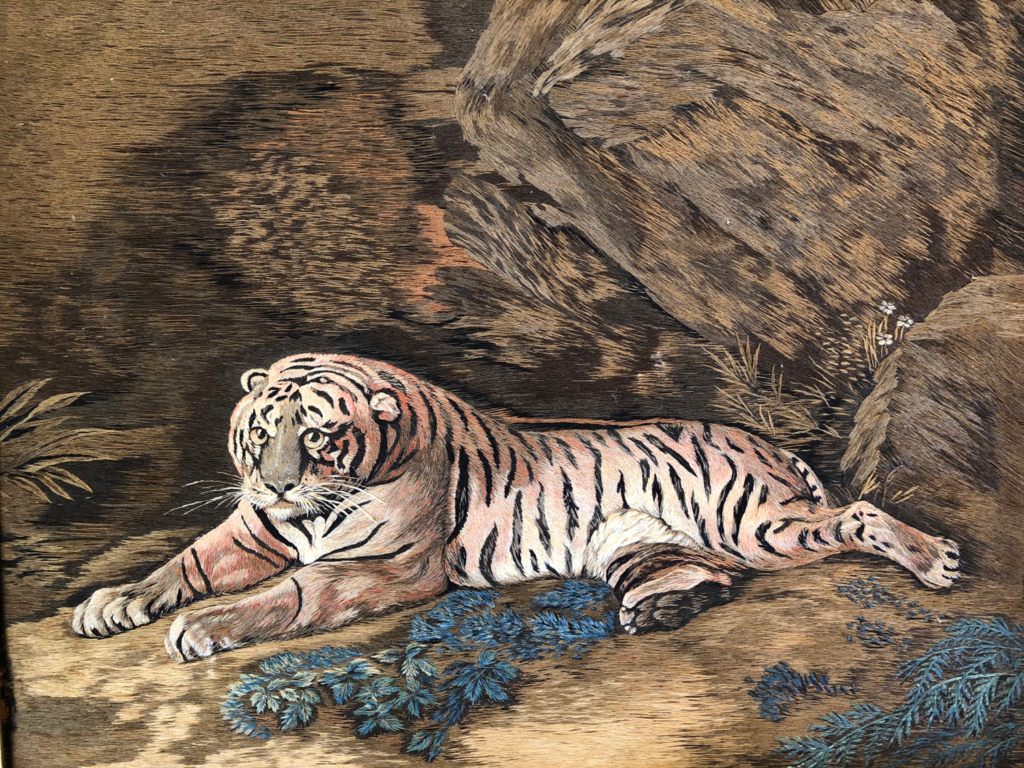
Tourist Tom Taylor described the Dens in which it was installed as a “yawn[ing] gloomy cavern with a terrible Tygress and a Lion and Lionesses after Stubbs.”
Linwood’s Contemporary Popularity
The author of a profile on Linwood in the London Monthly Mirror also marveled at the realistic qualities of her textiles. S/he wrote “the needle, in her hand, soon became like the plastic chisel of Praxiteles, upon a block of marble: she touched the ground-work, and the figures started into form.” The allusion to ancient Greek art softened the less orthodox (and less feminine) aspects of Linwood’s practice, such as her promotional activities and the public display of her work that contributed to her wealth.

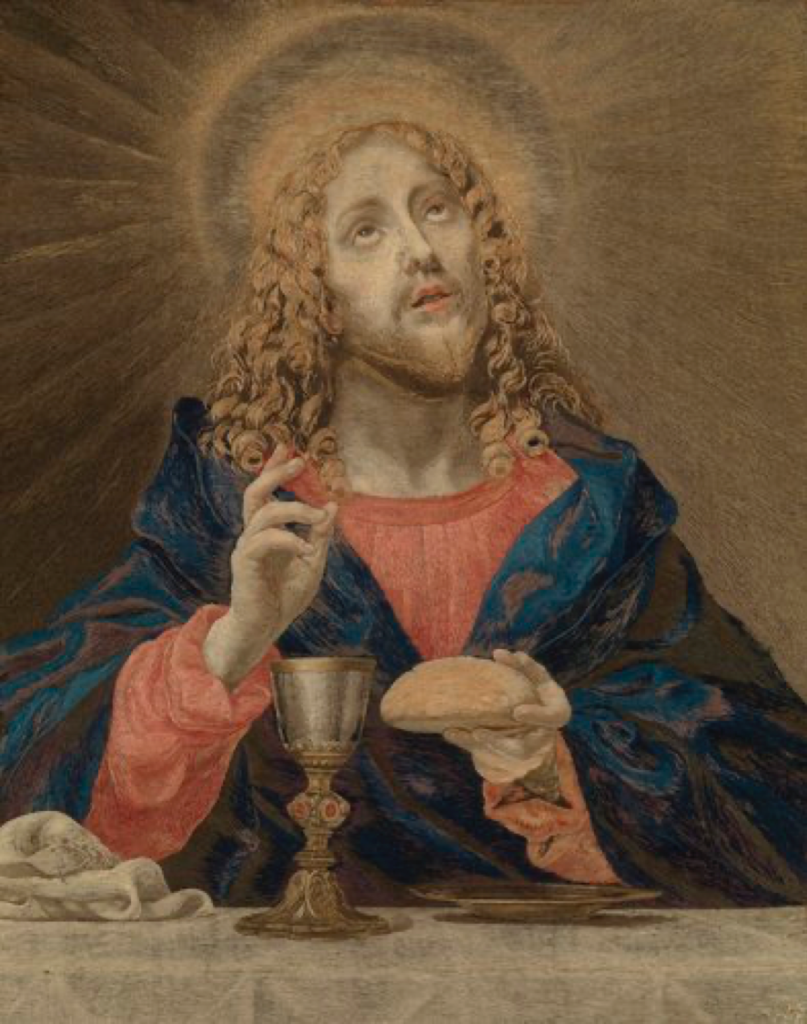
Linwood’s lifelike imagery is easy to see in her copy of Carlo Dolci’s Salvator Mundi, which she based on firsthand study of the original painting. She created dimensionality by layering her woolen thread. This Praxitelian (or sculptural) quality is particularly noticeable in the foreshortened bread that Christ holds aloft.
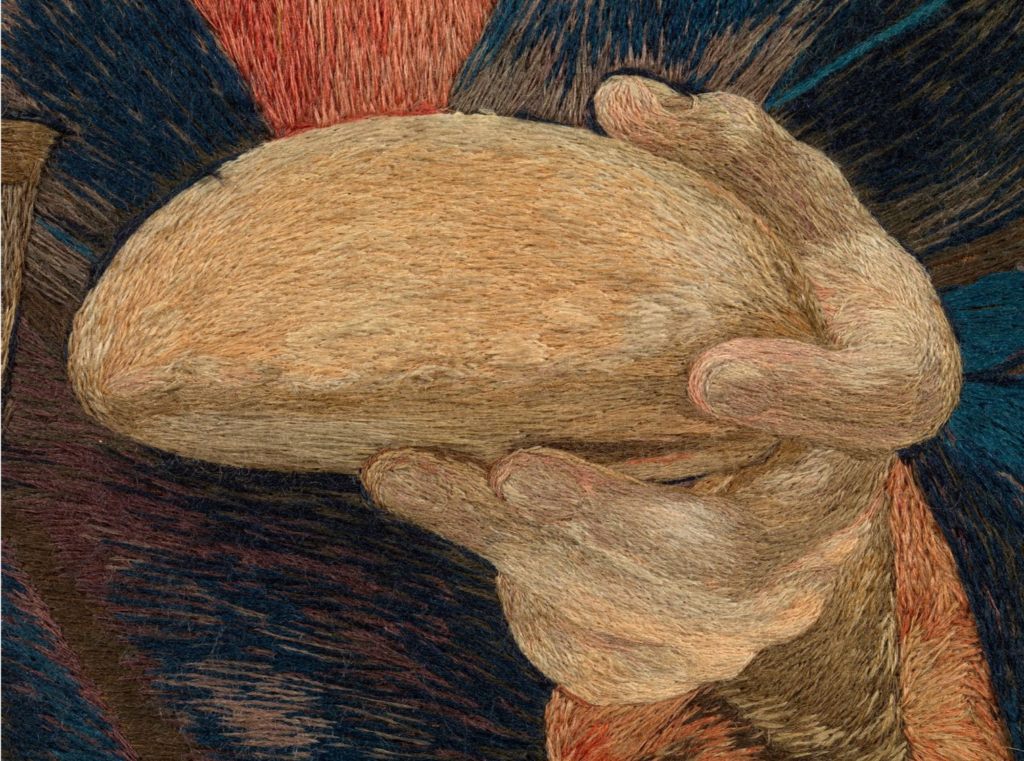
Linwood recognized the high quality of this textile, bequeathing it to Queen Victoria, as “an heirloom to the crown to behold and enjoy.” This act acknowledged the royal support that Linwood had received for decades, beginning with Queen Charlotte, and continuing with her daughter-in-law, Adelaide, who singled out the textile for praise during her 1831 visit to the Leicester Square Gallery. By bequeathing the Dolci replica to Queen Victoria, Linwood likely hoped that its display would educate and entertain visitors to the Royal Family and bolster her posthumous reputation.
Linwood’s Posthumous Reputation
The eighty-nine year old Linwood died in March of 1845, leaving her considerable wealth to her seventeen nieces and nephews and several British charities she had supported throughout her long life. In September of 1845, Christie’s auctioned her textiles at the Leicester Square Gallery. The sale garnered a disappointing £300, a sign of Linwood’s fall from popularity. Her textile copies fared poorly for several reasons. Because they were no longer displayed in her unique gallery, their quality depreciated. Additionally, her embroidery technique, which emulated brushstrokes, was replaced in popularity by Berlin woolwork favored by the Victorians.
More recently, Linwood’s work has been inaccurately described as craft, which modernist critic Clement Greenberg denigrated as not art. In 2014, the Folk Art exhibition at the Tate Britain was an opportunity to highlight Linwood’s work, where ten of her textiles were included in the show. Instead of recognizing her innovative display techniques and business acumen, Evening Standard art critic Ben Luke described her work “hideous and kitschy, if undoubtedly accomplished,” a derogatory description that links Linwood to the amateur tradition of accomplishment art. Such comments have compounded Linwood’s erasure from art history despite her pioneering role as the first (and self-made) female gallery owner in London.

[1] Linwood’s will (PROB 11/2019/315, UK National Archives) was proved by the Prerogative Court of Canterbury on June 2, 1845. The contents of Linwood’s home and school in Leicester were sold between June 3 and 6, 1845. For income calculations, see this webpage, accessed September 23, 2018. This calculation is based on the GDP (Gross Domestic Product) deflator.
Heidi Strobel is the chair of the Art History Department at the University of North Texas (Denton). Her research focuses on the intersection of gender and eighteenth-century material culture. Strobel’s publications include The Artistic Matronage of Queen Charlotte (1744–1818): How a Queen Promoted Both Art and Female Artists in English Society (2011). She co-edited Materializing Gender in Eighteenth-Century Europe (2016, with Jennifer Germann), which included her essay “Mary Linwood, Thomas Gainsborough, and the Art of Installation Embroidery,” an analysis of Mary Linwood’s innovative display practices and emulation of Thomas Gainsborough. Linwood is the subject of Strobel’s The Art of Mary Linwood: Embroidery, Installation, and the Entrepreneurship in Britain, 1787–1845, a monograph and catalogue of Linwood’s works (Bloomsbury, 2023). Recent publications also include “Women’s Embroidered Self-Portraiture in the Late Eighteenth Century: Authorship, Agency, and Artistry,” in Literature Compass (2021).
More Art Herstory posts about textile and/or fiber art:
The Theatrical Wonders of Jeanne Paquin’s Belle Époque Parisienne, by Julia Westerman
“Black-works, white-works, colours all”: Finding Susanna Perwich in her Seventeenth-Century Embroidered Cabinet, by Isabella Rosner
Hearts of Our People: Native Women Artists, by Elizabeth Sutton
Warp and Weft: Women as Custodians of Jewish Heritage in Italy, by Anastazja Buttitta
More Art Herstory posts about eighteenth-century women artists:
Finding Catherine Read, by Adam Busciakiewicz
Angelica Kauffman: Art, Music and Poetry, by Ellice Wu
Exhibiting Women: The Art of Professionalism in London and Paris, 1760–1830, by Paris Spies-Gans
Marie-Thérèse Reboul Vien: Finding the Natural in the Neoclassical, by Tori Champion
Madeleine Françoise Basseporte’s Hyacinths at the French Court, by Mary Creed
Seductive Surfaces: Anne Vallayer-Coster’s Vase of Flowers and Conch Shell at the Met, by Kelsey Bresnan
Marie-Guillemine Benoist, Revolutionary Painter, by Paris Spies-Gans
A Short Reintroduction to the Life of Anna Dorothea Therbusch (1721–1782), by Christina K. Lindeman
Adélaïde Labille-Guiard: Artist, Friend, Teacher, by Jessica L. Fripp
Rosalba Carriera at The Frick Collection, by Xavier F. Salomon
Angelica Kauffmann: Grace and Strength, by Anita V. Sganzerla
“I feel again the violence of a curious desire”: Rare client testimonies on Rosalba Carriera’s erotic art, by Angela Oberer
Rediscovering the Once Visible: Eighteenth-Century Florentine Artist Violante Ferroni, by Ann Golob




Trackbacks/Pingbacks